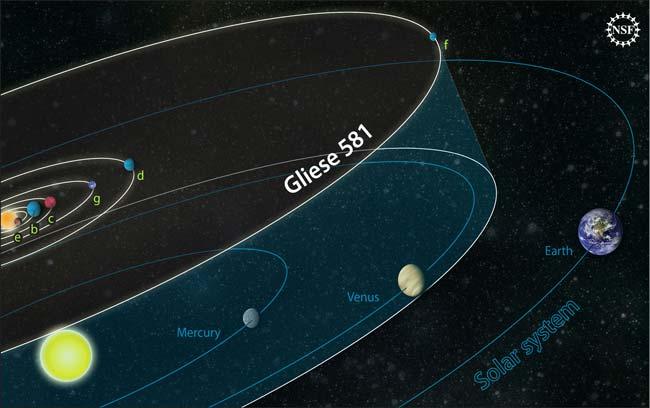The universe is deep and dark and we have no idea how much vast it could be. To understand the immensity and vastness of the universe, one must consider an infinite length of possibilities because the mere portion of the universe, we are aware of is already enough to confound our imagination. The massiveness of the cosmos never lets us forget about our place in the universe which is even less than a single grain of sand.
Among all the secrets that the universe hides in itself the most curious one is – Is there life in outer space? This is the question that arises in every curious mind. Carl Sagan once said “Somewhere, something incredible is waiting to be known”, giving us hope that we are not alone in this dimension and if we continue our search for the years to come, who knows, might we will find some unknown creature or might they approach us. Until then hope is what keeps us thinking that we are not alone in this universe.
“Somewhere, something incredible is waiting to be known”.
Carl Sagan
Gliese 581 planetary system
Around more than 20.22 light-years away, there lies a gravitationally bound Gliese 581 planetary system, comprising 6 known planets, Gliese 581e, Gliese 581b, and Gliese 581c, Gliese 581d, Gliese 581g, and Gliese 581f revolving around a star Gliese 581 the red dwarf, producing flames and showing some dusky marks on its surface. Red Dwarf is not as luminous as Sun and it does not produce the heat of such a high intensity as compared to the Sun.
Out of these 6 planets Gliese 581d, Gliese 581c, and Gliese 581g are present in a habitable zone. They are located at a distance suitable from Gliese 581 star to allow liquid water to flow on their surface.
For a planet to be habitable, it should meet certain requirements, most importantly it should be far enough from its star to maintain the temperature needed for life to survive. The gravity should be strong enough to hold thick atmosphere which can reflect the rays coming from the star. The surface pressure must not be too high or else water will not be able to stay in liquid form. Gliese 581d, Gliese 581c, and Gliese 581g fulfill all the requirements for a habitable planet.
Gliese 581d
Gliese 581d is a terrestrial planet discovered in 2007 and around 7 times larger than earth. It has all the suitable conditions for the survival of life as it is located in a habitable zone, not so close to Gliese 581 star with suitable temperature ranges. The climate is comparatively warm and mild enough due to the greenhouse effect along with a possibility of having oceans, clouds and microbial life.
It orbits at a distance of 20 million miles from its star and completes its rotation around red dwarf in 67 days so, one year at Gliese 581d consists of 67 days. The tidal forces present on Gliese 581d have made the orbital period equal to the rotational period, therefore at one side of the planet there is always night and at the other side of the planet, stays bright.
The atmosphere is thick enough and holds a sufficient amount of carbon dioxide to sustain a suitable habitable zone on the surface of Gliese 581d. Scientists conclude that the gravitational force of Gliese 581d is twice as much as that of earth. It has a thick atmosphere and denser air than earth. Even if humans were to visit this planet someday in the future, it will be quite a peculiar place, though suitable for life however not exactly familiar to earth.
According to astronomers, a habitable planet is the one which can support life not necessarily the one on which humans can flourish or prosper. There are many conditions needed for a habitable planet however, liquid water and suitable atmosphere are the two most important ones and luckily they both are present on Gliese 581d.
Astronomers consider Gliese 581d to be the next home for the human race after earth. This planet might be a sign of hope for humans in this dark, deep and immense universe. However, there is one set back that is the distance between the earth and Gliese 581d. It lies at a distance of about 120 trillion miles from planet earth. In 1977, Voyager 1 launched heading towards Gliese 581d, thirty years later it has traveled more than 13 billion miles although traveling a distance of 11 miles a second still approximate time for Voyager 1 to reach Gliese 581d is around 350,000 years.
In 2009, several messages collected from around 195 countries, these messages transmitted from Tidbinbilla, Australia, on August 2009 through a radio telescope (DSS-43 70m) at the Canberra Deep Space Communication Complex.
Gliese 581c
Gliese 581c is the third planet orbiting around the star Gliese 581, discovered in 2007 by radial velocity method. Astronomers estimated the presence of this planet in the habitable zone of Gliese 581. There are chances that water might present on this planet. Although the recent study shows that Gliese 581c might have a Venus-like atmosphere, which is the hottest planet of our Solar system. However, unlike the sun, the mass of Red Dwarf is exceedingly small. Gliese 581c is the smallest planet of the Gliese 581 system, it is terrestrial and rotates around its star in 15 days. Gliese 581c is also given the name of “Hell Planet” because of its crimson sky as it is very close to the Red dwarf. This low-frequency red light will affect the vegetation on Gliese 581c if there will be any in the future.
Even though Gliese 581c has categorized as super-earth, researches have concluded that the actual conditions on this planet are not very earth-like, as the atmosphere should be thick enough to sustain a suitable temperature and to reflect enough light from the planet for the survival of life. As Gliese 581c orbits around its star, it keeps its one side towards it. The planet is tidally locked exactly like Earth’s moon. According to this observation one side of Gliese 581c is always warmer and brighter than the other side which means it does not have a regular day and night cycle as on earth. So even if the water is present on Gliese 581c, it will not be in liquid form.
The water on the warm side evaporates because of the heat and water on the colder side will turn into ice. It does contain an atmosphere but the composition is still unknown. As Gliese 581c is 15 times closer to the red dwarf as compared to the distance between earth and sun. The atmosphere should be thick enough to reflect the rays coming from the red dwarf and the surface temperature ranges between 32 to 104 F.
On October 9, 2008, Ukraine’s National Space Agency beamed a high power radio signal towards Gliese 581c, though it was able to cross Mars in four minutes after being launched by a massive RT-70 radio telescope, it would not reach Gliese 581c, its destination, till 2029. The message sent includes images of famous people, landmarks, and several notes giving a brief description of earth and different life forms on earth.
Gliese 581g
This planet seems to be more habitable as a comparison to Gliese 581d and Gliese 581c. It is a newly founded planet of Gliese 581 planetary system, discovered on September 29, 2010, by radial velocity method and it is around 4 times massive as earth. Gliese 581g completes its orbit around the habitable zone of Red dwarf in about 37 days. So one year on Gliese 581g equals to 37 earthly days. Scientists say this planet is also terrestrial and it also contains an atmosphere. The temperature here is also suitable enough for the presence of liquid water. The surface gravity of Gliese 581g is 1.1 to 1.7 times than the gravity of earth which means that weight would increase up to 70 percent on Gliese 581g.
Just like Gliese 581d and Gliese 581c, Gliese 581g is also tidally locked to its parent star. During its orbit it keeps its one side facing the star so one side of the planet is always bright and one the other side it is always night time.

Rida Fatima is currently enrolled in the capital university of science and technology, Islamabad for Bachelors degree in Biosciences. She has been a freelance content writer for 2 years now. She is seeking to write promotional and informational content for websites through her ideas and views through writing.

